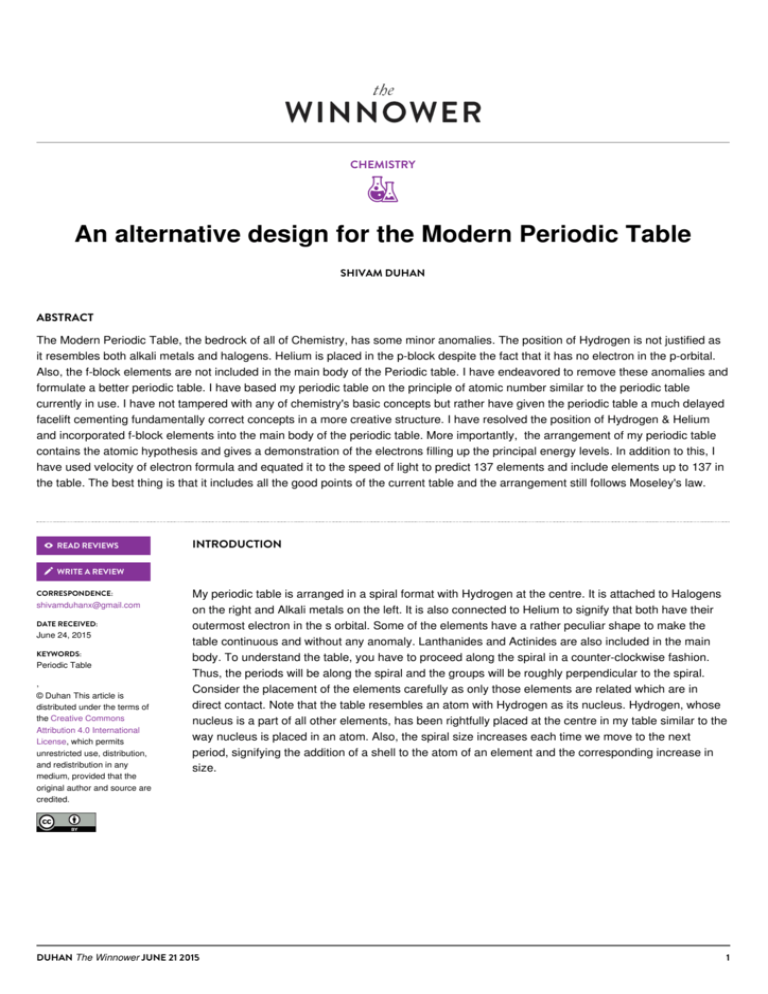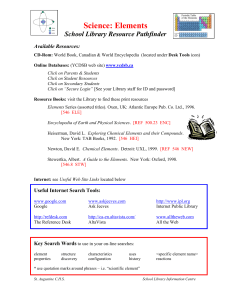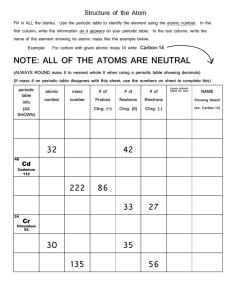An alternative design for the Modern Periodic Table
advertisement

CHEMISTRY An alternative design for the Modern Periodic Table SHIVAM DUHAN ABSTRACT The Modern Periodic Table, the bedrock of all of Chemistry, has some minor anomalies. The position of Hydrogen is not justified as it resembles both alkali metals and halogens. Helium is placed in the p-block despite the fact that it has no electron in the p-orbital. Also, the f-block elements are not included in the main body of the Periodic table. I have endeavored to remove these anomalies and formulate a better periodic table. I have based my periodic table on the principle of atomic number similar to the periodic table currently in use. I have not tampered with any of chemistry's basic concepts but rather have given the periodic table a much delayed facelift cementing fundamentally correct concepts in a more creative structure. I have resolved the position of Hydrogen & Helium and incorporated f-block elements into the main body of the periodic table. More importantly, the arrangement of my periodic table contains the atomic hypothesis and gives a demonstration of the electrons filling up the principal energy levels. In addition to this, I have used velocity of electron formula and equated it to the speed of light to predict 137 elements and include elements up to 137 in the table. The best thing is that it includes all the good points of the current table and the arrangement still follows Moseley's law. READ REVIEWS INTRODUCTION ✎ WRITE A REVIEW CORRESPONDENCE: shivamduhanx@gmail.com DATE RECEIVED: June 24, 2015 KEYWORDS: Periodic Table , © Duhan This article is distributed under the terms of the Creative Commons Attribution 4.0 International License, which permits unrestricted use, distribution, and redistribution in any medium, provided that the original author and source are credited. My periodic table is arranged in a spiral format with Hydrogen at the centre. It is attached to Halogens on the right and Alkali metals on the left. It is also connected to Helium to signify that both have their outermost electron in the s orbital. Some of the elements have a rather peculiar shape to make the table continuous and without any anomaly. Lanthanides and Actinides are also included in the main body. To understand the table, you have to proceed along the spiral in a counter-clockwise fashion. Thus, the periods will be along the spiral and the groups will be roughly perpendicular to the spiral. Consider the placement of the elements carefully as only those elements are related which are in direct contact. Note that the table resembles an atom with Hydrogen as its nucleus. Hydrogen, whose nucleus is a part of all other elements, has been rightfully placed at the centre in my table similar to the way nucleus is placed in an atom. Also, the spiral size increases each time we move to the next period, signifying the addition of a shell to the atom of an element and the corresponding increase in size. DUHAN The Winnower JUNE 21 2015 1 AN ALTERNATIVE DESIGN FOR THE MODERN PERIODIC TABLE : CHEMISTRY Figure 1: Sketch of my alternative design of the modern periodic table. SOLUTION OF ANOMALIES POSITION OF HYDROGEN & HELIUM The properties of Hydrogen resemble both alkali metals and halogens; therefore it is placed in the middle connected to both groups. In addition it lies in the s-block along with Helium and is thus connected to it with a line indicating that Hydrogen resembles only Helium, and no other noble gas, in this regard. POSITION OF F-BLOCK Lanthanides and Actinides have been included in the table by including a projection in the table giving further evidence of the flexible structure of the table. This also suggests a way to include the g-block elements in the table when they are discovered. Number of elements I have found the maximum number of elements possible by using the formula for velocity of electron in nth orbit, considering the 1st orbit (as the electron has the maximum velocity in this case and thus it will approach the speed of light earliest) and equating it to the speed of light (as nothing can go faster than the speed of light). The answer comes out to be 137.61 and applying the greatest integer function to it yields 137. Using IUPAC nomenclature for elements over the atomic number 112, I have accordingly included 137 elements in my version of the periodic table. This is based on the assumption that the simple velocity of electron formula holds for all elements. According to the atomic theory, DUHAN The Winnower JUNE 21 2015 2 AN ALTERNATIVE DESIGN FOR THE MODERN PERIODIC TABLE : CHEMISTRY Here v is Velocity of electron, Z is atomic number and n is the principal quantum number. Equating Velocity of electron with the speed of light, Taking ; & Greatest Integer (Z) = 137 Conclusion Through my periodic table, I have resolved the position of Hydrogen and Helium and included Lanthanides and Actinides in the main body of the periodic table. I have calculated the total number of elements possible in the universe. I have arranged the table in the form of an atom – thus including the knowledge of the atomic hypothesis in the periodic table. Also, the structure of my periodic table indicating the progressive filling up of energy levels gives an idea of the structure of the atom and the quantum theory. Building upon existing knowledge, my periodic table provides a refreshingly new way of arranging the elements. Overall, my periodic table is an alternative modern periodic table free of all anomalies. DUHAN The Winnower JUNE 21 2015 3





